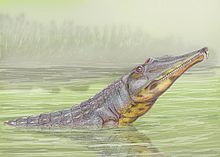Thecodontia

Thecodontia (meaning 'socket-teeth'), now considered an obsolete taxonomic grouping, was formerly used to describe a diverse "order" of early
Definition
Thecodonts are characterized by certain shared primitive features, such as the antorbital fenestra (an opening on each side of the skull between the eye sockets and the nostrils) and teeth in sockets. The name thecodont is Greek for "socket-tooth", referring to the fact that thecodont teeth were set in sockets in the jawbones; an archosaurian characteristic that was inherited by the dinosaurs. While the taxon Thecodontia is obsolete, the term thecodont remains in use as an anatomical description of teeth in bony sockets; in addition to species formerly in this group (such as crocodiles and dinosaurs), mammals also possess thecodont dentition, which evolved independently.
They constitute an evolutionary grade of animals, a "
Taxonomic history
Traditionally, the order Thecodontia
Robert Carroll, in his book Vertebrate Paleontology and Evolution (1988), replaces Pseudosuchia with Rauisuchia, Ornithosuchia, and the traditional category incertae sedis (of uncertain placement), while retaining the other three suborders. This is the last major textbook that still recognizes the taxon Thecodontia, as it uses a traditional Linnaean based taxonomy.
References
- Benton, M. J. 1997, Vertebrate Paleontology, Blackwell Science Ltd
- Carroll, R. L. 1988, Vertebrate Paleontology and Evolution, W. H. Freeman and Co. New York
- Colbert, E H. 1969, Evolution of the Vertebrates, John Wiley & Sons Inc (2nd ed.)
- Gardiner, BG (1982). Tetrapod classification. Zool. J. Linn. Soc. London 74: 207–232.
- Gauthier, J., 1986. Saurischian monophyly and the origin of birds. In: K. Padian, ed. The Origin of Birds and the Evolution of Flight. Memoirs California Academy of Sciences 8. pp. 1–55
- Sereno, P. C. 2005. Stem Archosauria—TaxonSearch [version 1.0, 7 November 2005]
External links
- Evolution Wiki: Thecodont
- Five types of tooth implanting in non-mammals, including thecodont type at the Wayback Machine (archived November 26, 2010)
- Dinosaurs of Rio grande do Sul.
